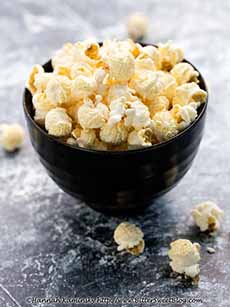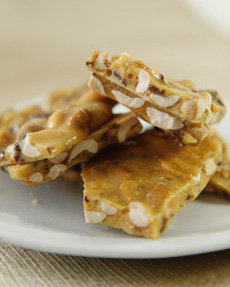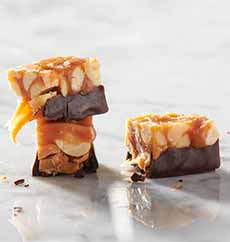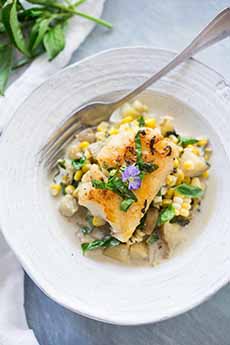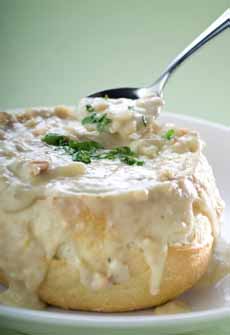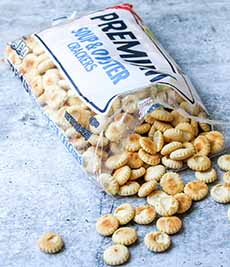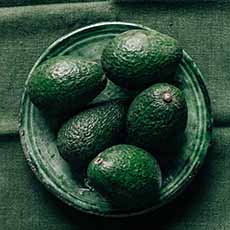|
If you like nutty flavors, you’ll like tahini (photo #1): a creamy, nutty paste made from ground sesame seeds. It’s familiar to every fan of hummus (photo #3).
Most Americans buy tahini to make hummus or baba ghanoush. If you eat halvah, you’ve eaten tahini-based candy.
Tahini is also the base of tarator sauce (the recipe is below**), a multipurpose Middle Eastern staple used for meats, vegetables and seafood, plus falafel (photo #4), shwarma and other pita sandwiches.
The history of tahini is below.
We were inspired by a jar of Once Again Tahini (photo #2) to experiment with uses beyond our favorite Middle Eastern dishes.
By the way, along with tahini, Once Again makes artisan nut and seed butters, including almond, cashew, peanut, and sunflower butters. The products have just one ingredient: nuts or seeds. The company is employee owned, and dedicated to Fair Trade, Fair Labor and sustainability.
WHAT IS TAHINI?
Tahini paste is a Middle Eastern staple.
In most Middle Eastern cultures, the paste is called tahina, from the Arabic tahn, meaning “ground.” Most Western countries use the Greek spelling, tahini.
Think of tahini as sesame butter. You can substitute it for a no-nuts peanut butter. Some fans eat it from the jar, like PB.
To make tahini, sometimes the sesame seeds are first roasted, sometimes they are raw. The flavor is an individual preference; although tahini made from raw sesame seeds is lower in fat than tahini made from roasted seeds [source].
The seeds can be hulled or unhulled. You may prefer the hulled seeds because they have a less bitter taste. However, as with whole grains, the unhulled sesame seeds provide more fiber and other nutrition. When tahini is made from unhulled roasted seeds, it’s darker, more bitter, and called sesame butter [source].
The ground paste can be mixed with a bit of oil for a consistency that’s similar to homemade peanut butter.
Like homemade peanut butter, which lacks the the emulsifiers that keep big brand PBs from separating, some of the natural oil of the ground seeds rises to the top. Just stir it back in before measuring out what you need.
Because of tahini’s high oil content, it should be refrigerated after opening to keep it fresher, longer. You can even freeze it.
If you have a cost-effective source of sesame seeds, you can whir them in your food processor to make your own tahini—in just 20 minutes. Here’s how.
TAHINI NUTRITION
Seeds—chia, flax, hemp, pumpkin, sesame, sunflower—are good for you (more about seed nutrition). Tahini, in particular:
Vitamins. Is high in vitamin E and vitamins B1, B2, B3, B5 and B15 (the benefits of B vitamins).
Minerals. Is rich in minerals such as calcium, iron, lecithin, magnesium, phosphorus and potassium. If you need more calcium for bone strength, tahini has nine times more calcium than PB.
Protein. Tahini has 20% complete protein, making it a higher protein source than most nuts; and it’s easily digestible [source].
Fiber & Fatty Acids. Sesame is a good source of both dietary fiber and monounsaturated fats. Tahini is a source of the healthy fatty acids omega-3 and omega-6.
Here’s more on tahini nutrition.
BEYOND THE MIDDLE EAST: WAYS TO USE TAHINI
There’s so much more to do with that bottle or can of tahini paste that is a step apart from Middle Eastern cuisines.
Use it to make fusion food: the integration of ingredients from one cuisine into another.
Tahini can be mixed in to other foods, thinned into a sauce, and used plain or augmented in:
Dairy, mixed into cottage cheese, crème fraîche, sour cream or yogurt to create new flavors.
Dips, e.g. for crudités (try this red pepper dip and this green dip for St. Patrick’s Day; or this dip below††).
Dressings: as a binder in chicken salad, potato salad, etc., alone or mixed with mayo.
Grains, mixed in or as a garnish.
Marinades.
Noodles (we use it instead of peanut butter on sesame noodles; for everyday pasta or pasta salad, add lemon and garlic).
Nut butter substitute.
Salad dressings, for dairy-free creaminess in green salads.
Sandwich and burger spreads, especially on chicken, turkey and plant-based burgers
Sauces for chicken, fish, grains, lamb, vegetables
Soups (add a couple of tablespoons to thicken and enhance flavor)
Sweets: brownies, candies (e.g. caramels), cookies, ice cream
Toast spread (use it with avocado toast)
Vegetables: grilled, steamed (try it in a baked potato)
Vinaigrettes—add a splash of tahini or try the recipe below‡‡
World cuisines: beyond tahini with American fare, integrate it with other cuisines†
Check out these 18 modern recipes with tahini.
TAHINI HISTORY
Sesame seeds grow in the pods of a flowering plant.
The plant, Sesamum indicum, is the best-known member of the genus that includes other annual or perennial herbs with edible seeds.
Sesame is native to sub-Saharan Africa and India. The plant is hardy, and can grow in drought conditions [source].
Today sesame is widely grown in India and Asia. The tiny seeds can be in shades of shades of black, brown and red, depending on the cultivar; but the most common color is a pale ivory [source].
Tahini was originally a byproduct of sesame oil production, but became a valued food in its own right. Sesame seed contains between 45% to 55% oil, and is notable for its resistance to rancidity [source].
Sesame seed has been cultivated in Egypt since at least 2 C.E., first as a source of oil.
Egypt. The oldest mention of sesame is in a cuneiform document written 4,000 years ago that describes the custom of serving the gods sesame wine.
The addition of sesame seeds to food is shown in an ancient Egyptian tomb painting, that depicts a baker adding the seeds to bread dough [source].
Greece. The ancient Greeks used sesame seed as medicine as well as food. Hippocrates, the great Greek physician, is said to have recommended sesame for its nutritional value.
The Greek historian Herodotus wrote about the cultivation of sesame 3,500 years ago, in the region of the Tigris and Euphrates in Mesopotamia. It was mainly used as a source of oil.
India. The ayurvedic medicine of India, which dates back to 3300–1300 B.C.E, recommends sesame seeds to nourish and keep the body healthy. The belief is that the seeds’ high oil content lubricates and protects the tissues.
Persia. The concept of sesame paste (tahini), rather than oil, came from Persia, where it was called ardeh*. Tahini next moved to Israel.
Baghdad (modern Iraq). Tahini is mentioned as an ingredient of hummus kasa, a recipe transcribed in an anonymous 13th-century Arabic cookbook, Kitab Wasf al-Atima al-Mutada [source].
A PRICEY SEED
For centuries, only the wealthy could obtain the sesame seeds to make tahini.
In some cultures, the seeds were used as currency—much as the hard-to-obtain peppercorns were once used in Europe [source].
Perhaps that’s why “Open Sesame” was chosen as the magical phrase that opened the treasure cave, in the story of Ali Baba and the Forty Thieves (although the tale was written at the beginning of the 18th century, so it may be a stretch).
TAHINI COMES TO THE U.S.
Tahini began to appear in the U.S. in the 1940’s, in health food stores.
In 1965, the U.S. passed new immigration reforms, allowing new waves of Arabs, Asians and other nationalities to immigrate [source].
They brought their cuisine with them, of course. Middle Eastern restaurants and grocers ultimately attracted other Americans into the fold.
These days you can purchase tahini in most supermarkets. There’s even a tahini dry mix seasoning, made with toasted sesame seeds, black pepper, citric acid, garlic, sea salt and parsley.
By the way, in the southern U.S., sesame seeds are known as benne, a name brought from Africa by enslaved people‡.
The word “sesame” that we use is of Semitic origin, reaching the English language in the 15th century via the Greek sesamon and Latin sesamum.
________________
*In addition to savory tahini/ardeh, in Iran there is halvah ardeh: a sweet, dense paste made with ground sesame or tahini, and occasionally studded with pistachios [source].
†In Indian cuisine, for example, tahini is served with breads, chicken, chickpeas, eggplant, fish, lamb, noodles, etc. It is generally added to make thick and rich gravy based curries [source]. In addition to India, tahini is found in the cuisines of Africa, Israel, Iran, Japan, Turkey, Turkey, even China, Japan, Korea and Vietnam.
‡The word benne (also spelled bene, pronounced benny) means sesame in the language of the Bambara peoples of Mali, and among the Wolof of Senegal and Gambia [source].
**To make tarator sauce and add a fresh tang to almost any dish, just combine 1/2 cup tahini, 1/2 cup lemon juice, 4 cloves minced garlic and 1/4 cup chopped parsley. Pulse in a food processor until combined.
††For an easy dip, add lemon juice, salt and a dash of pepper or hot sauce to the tahini. A recipe for lemon tahini dressing: Combine 1/4 cup tahini, 3 tablespoons lemon juice, 1 clove pressed garlic, 1 tablespoon chopped cilantro, 4 tablespoons water (or enough to reach desired consistency), and salt and pepper to taste.
‡‡An easy tahini dressing recipe: Combine in a blender or food processor 1/2 cup tahini and 1/2 cup olive oil with 2 teaspoons apple cider vinegar, 2 teaspoons of lemon juice, and 2 teaspoons of grated ginger. Pulse and serve.
|
|
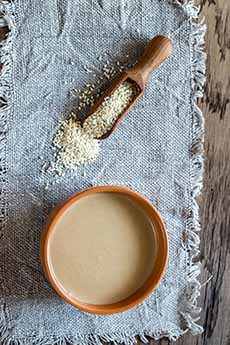
[1] Tahini paste (photo © Alex9500 | Panther Media).

[2] Once Again has plain unsweetened, unsalted tahini, plus this version with lemon (photo © (photo © Once Again Nut Butters).

[3] A Greek salad and quinoa bowl with hummus, the latter being the best-known use of tahini in the U.S. Here’s the recipe (photo © Baked Greens).

[4] Falafel with tahini sauce, its most familiar use in the U.S. after hummus (photo © Alesia Kozik | Pexels).

[5] Fish in tahini sauce (photo © Jennifer Pallian | Unsplash).

[6] Add tahini or tarator sauce to grilled vegetables (photo © Once Again Nut Butters).
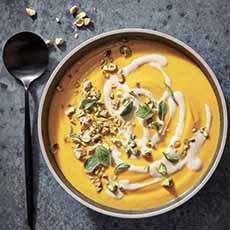
[7] Tahini as a soup garnish. Here’s the recipe from Cooking Light (photo © Cooking Light).

[8] Potato salad with a tahini-herb dressing. Here’s the recipe (photo © Blue Diamond).

[9] Add tahini to mayo, or use by itself, in egg salad, tuna salad, etc. Here’s the recipe for this chicken salad sandwich (photo © Sara Tane | My Recipes).

[10] Getting fancy at Kindred restaurant: scallops with whipped tahini and artichoke crisps (photo © Kindred Restaurant | Davidson, North Carolina).

[11z] An elegant watermelon radish and avocado salad with tahini dressing (photo © Matthew Kenney Cuisine).
|

